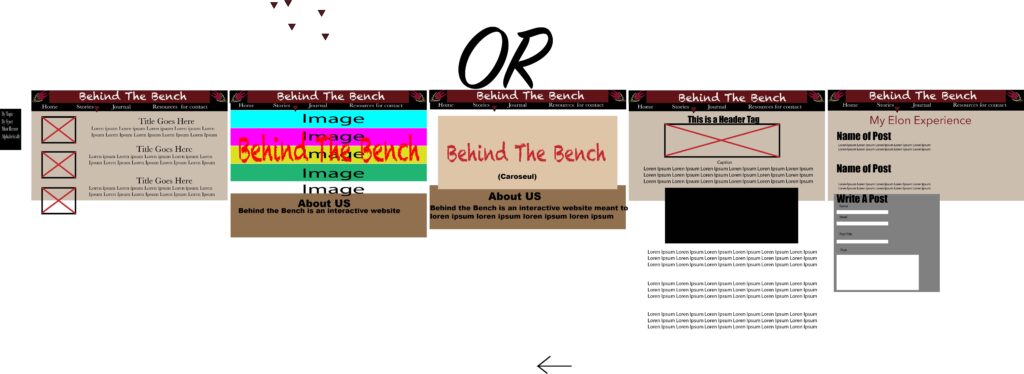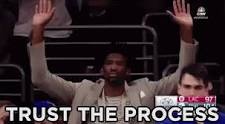It all started with a sketch

I made this sketch at the beginning of the project to try and map out what the site might look like to achieve my goals. At the beginning of this project, I was trying to find the ideal balance between designing this site to be as informative as I could to my target audience while achieving my personal goals of showcasing my skills in writing, conducting interviews, and creating graphics and videos. My original sketch for Behind the Bench envisioned a platform where interviews were conducted with athletes, and their stories were told through a mixture of written text and videos to keep viewers engaged throughout a long form story.
This project was divided into six “sprints”- two week periods where I set goals for myself to try and break down a large project into more manageable chunks. During our “Sprint 0”- a pre-production sprint, I scheduled interviews, practiced my video editing skills, wrote interview scripts, and practiced embedding content into WordPress. During Sprint 1, I completed my first interviews and designed a prototype for my website, which can be seen here

Through the two sprints, everything was going relatively smoothly. I was putting interviews together and had a good idea of how I was going to incorporate them into the site. Then I ran into trouble.
The Coronavirus pandemic forced Elon to close at Spring Break, meaning I would have to finish the remainder of the project from home, and rely on platforms like Skype and Zoom to finish my interviews. Working 700 miles away from campus posed a number of challenges, and I realized I was going to have to make adjustments to my project. It was the first major roadblock I had encountered.

My New Process

The original target audience of Behind the Bench was current and prospective student athletes at Elon University, and that was reflected in the original color scheme and logo for the site, as well as the people I had interviewed. Being away from Elon would mean rethinking who my target audience would be and I began to shift the project away from Elon athletes toward current and prospective college athletes as a whole. I interviewed personal connections who had played a sport while in college, and this was helpful because it provided the prospective of someone who had been an athlete at a smaller college and had a different experience.
During Sprint 2, I conducted some more interviews- two in person and two more online. I created a motion graphic and some more of the graphics for my site as well. I first created a storyboard seen below, then designed the graphics in Adobe Illustrator and imported them to Adobe After Effects to animate them. This motion graphic can be seen at the top of the activities page.
By the beginning of Sprint 3, I had completed the interviews, and I transcribed them into a 15 page document, where I searched for common themes that could tell a story about their experiences. I began to put my site together during this sprint by purchasing a domain name and selecting a WordPress theme. I wrote drafts of three stories based on the questions I had asked and the answers I received, with the help of additional online research articles. I used this information to write the stories on mental health in college athletes, post-grad career information, and navigating the recruitment process. My goal was to take the video footage I had from the interviews and edit them together for each story to enhance the multimedia experience, but then near the end of Sprint 3 I ran into another major roadblock.
By the beginning of Sprint 3, I had completed the interviews, and I transcribed them into a 15 page document, where I searched for common themes that could tell a story about their experiences. I began to put my site together during this sprint by purchasing a domain name and selecting a WordPress theme. I wrote drafts of three stories based on the questions I had asked and the answers I received, with the help of additional online research articles. I used this information to write the stories on mental health in college athletes, post-grad career information, and navigating the recruitment process. My goal was to take the video footage I had from the interviews and edit them together for each story to enhance the multimedia experience, but then near the end of Sprint 3 I ran into another major roadblock.

At this point of the project, being at home was beginning to cause major problems. I found that my computer was too small to handle certain large video files and video editing software, and I did not have access to the larger lab computers on Elon’s campus. Furthermore, I could not get onto campus to take additional B-roll shots and photographs to add to the videos. I realized I was going to have to improvise, and I decided to replace the video portion of my project with interactive graphics.
In Sprint 4, I used a software program called Ceros to create an interactive infographic on how long the average professional career lasts in five major U.S sports. I started by researching these statistics, designing graphics in Adobe Illustrator, and importing them into Ceros to make them interactive. I used Ceros to make the graphics clickable, and I redesigned the pop-up window that opens each time a graphic is clicked to make the windows larger and more user friendly. I used the same method to create the “A Day in the Life of an Athlete” story by taking the information my interviews had provided me and figuring out how to turn it into a story. I designed the graphics in Adobe Illustrator and imported them into Ceros to make them interactive.
Finally, I created an activities page in an effort to make the site more appealing for younger viewers interested in learning more about what behind the scenes life was like for their favorite college athletes. The activities page featured a motion graphic I had designed earlier in the project (which I had originally planned to put on the home page), the interactive story, and a quiz and word search I made using the Quiz Cat and H5P plugins respectively.
During Sprint 5, I edited the existing content of my site and added in stock photographs from unsplash.com. I added content into my footer and made sure the layout of the site was navigable and user friendly.